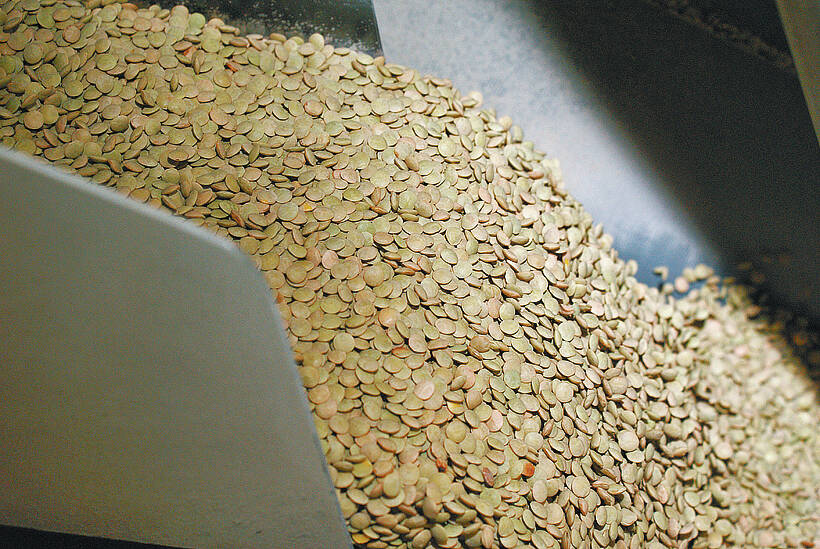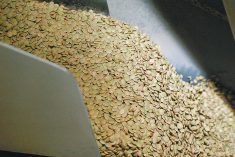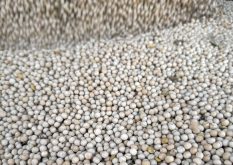Fed market weakens
U.S. beef prices fell last week after posting a 4½ year high the week before. The normal trend is for weaker values as the dog days of summer arrive, but fed cattle prices in the United States dropped more than usual, reflecting a reversal from the strong contra-seasonal rally in June. The weak U.S. economy might reduce beef demand.
Fed cattle prices in Western Canada fell $3 per hundredweight last week following the U.S. market and the stronger Canadian dollar, said Canfax.
Read Also

Green lentil market oversupplied
Farmers in Western Canada can expect price pressure on their new crop of green lentils, as the available supplies among the world’s major lentil-growing nations increase significantly.
Alberta steers averaged $95.30 per cwt., down $2.91, and heifers fell $3.03 to $94.09.
Sales volume rose two percent to 24,500 head.
The cash to futures basis again narrowed to $2.82 under compared to $4.81 the week before.
U.S fed exports totalled 8,330, eight percent lower than last year.
While the Canadian market fell with the U.S. last week, market-ready supply in Canada is tight. The Canada-U.S. basis could tighten. Feedlots are current in their marketing, giving them a little leverage, said Canfax.
D1 and D2 cows in Alberta rose $1.11 to average $53.41 for the week. That is $9.42 higher than the same period a year ago.
The butcher bulls average rose $3.16 to $61.74.
Good demand should see prices steady to stronger this week.
U.S. beef falls
U.S. Choice cutouts fell $4.13 to $169.67 US and Select fell $5.28 to $161.34, said Canfax.
A weak U.S. economy could force consumers to switch to cheaper cuts or to cheaper pork and chicken.
The Calgary wholesale price for delivery this week fell $1 Cdn to $155-$162 and the Montreal wholesale rose $1 to $164. Byproduct values in Canada are strong. This month’s average price of $111.50 is the highest since April 2003.
Grain helps feeders
Feed prices fell sharply last week.
Feeder cattle volumes were down three percent from the week before at 16,612 head, said Canfax.
There was steady demand for a seasonally light volume.
The steer average rose $1.07 from the week before and heifers averaged $1.70 higher.
Alberta steers heavier than 700 pounds rose $2.23 per cwt. and heifers rose $2.01.
Steers lighter than 700 lb. saw limited but steady demand, rising 20 cents while heifers were $1.46 higher.
Heavier feeders with shorter feeding periods continue to see good demand, said Canfax.
Exports to the U.S. two weeks ago totalled 7,756 head, up 36 percent from the week before and up 61 percent from last year.
No bred cows traded.
Cow-calf pairs averaged $950, up $5. The range for pairs was from $600 to $1,270 so quality was variable.
Pork prices rise
Stronger pork prices and profitable packer margins helped raise U.S. cash hog values last week.
The average weight of barrows and gilts in Iowa-Minnesota for the week ending July 12 was up 0.9 lb. from a week earlier at 260.5 lb. but down 2.8 lb. from a year earlier. This indicates that producers are current in their marketing.
The U.S. Meat Export Federation said pork exports for May were up 98.2 percent over a year earlier. In the month, a little more than 25 percent of hogs slaughtered in the U.S. went to export markets.
Pork exports totalled 196,118 tonnes. China and Hong Kong combined to be the top buyer with 55,293 tonnes, five times more than a year earlier.
Year-to-date exports to all countries were 825,800 tonnes, up 60 percent.
Iowa-southern Minnesota cash hogs were $59 US per cwt. July 18, up from $56 July 11.
The U.S. composite pork carcass cut-out value July 18 was $83.11 per cwt., up from $81.12 July 11.
U.S. slaughter for the week ending July 19 was estimated at 2.145 million, down from 2.152 million the week before, and 9.6 percent more than last year.
Bison steady
The Canadian Bison Association said markets were a little stronger.
Grade A carcasses from youthful bulls in the desirable weight range in Canada rose five cents to $2.10-$2.30 per lb. hot hanging weight. Heifers were $2-$2.25 per lb. Cull cows and bulls were 90 cents to $1 per lb.
Lambs down
Ontario Stockyards reported 1,994 sheep and lambs and 142 goats traded July 14. All lambs were $5-$10 per cwt. lower. Sheep traded steady. Good fed goats held steady but thinner types were under pressure.
Beaver Hill Auction in Tofield, Alta., reported 1,865 sheep and lambs and 193 goats traded July 14.
Rising production costs and heavy predation from coyotes are causing producers to sell lambs early
Buyers said rising feed costs and problems pushing lamb meat prices higher have lessened their interest. The result was a heavy run and sharply lower prices.
Light lamb prices fell below heavy lamb prices. Beaver Hill recommends keeping lambs until they weigh at least 90 lb. and kid goats until they weigh 60 lb.
Lambs lighter than 70 lb. were $91-$112 per cwt. Lambs 70 to 85 lb. were $95-$116, 86 to 105 lb. were $112-$122 and those heavier than 105 lb. were $115-$122.
Rams were $30-$41 per cwt. Cull ewes were $25-$35 per cwt. Good kid goats were $160-$202.50.
Nannies were $62-$86 per cwt. and mature billies were $119-$152.50.














